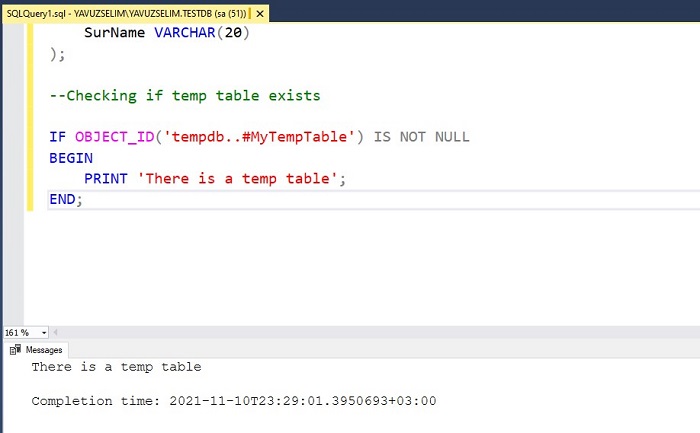When working with databases, temporary tables can be a valuable resource for managing and manipulating data. SQL temporary tables, in particular, offer a flexible way to store and retrieve data temporarily, making them useful for a wide range of applications. However, to get the most out of SQL temp tables, it's essential to understand how to use them effectively. In this article, we'll explore five SQL temp table tips to help you maximize their potential and improve your database management skills.
Key Points
- Understanding the differences between local and global temporary tables
- Effective use of indexing to improve query performance
- Managing temporary table storage and space efficiently
- Utilizing temporary tables for complex queries and data transformations
- Best practices for temporary table naming and organization
Tip 1: Understand Local vs. Global Temporary Tables

In SQL, temporary tables can be either local or global. Local temporary tables are prefixed with a single number sign (#) and are only accessible within the current session. They are automatically dropped when the session is closed. Global temporary tables, on the other hand, are prefixed with two number signs (##) and are accessible from any session. They are automatically dropped when the last session using them is closed. Understanding the scope and lifespan of these temporary tables is crucial for planning and managing your database operations.
Example: Creating Local and Global Temporary Tables
Here’s an example of creating both local and global temporary tables in SQL:
-- Create a local temporary table
CREATE TABLE #LocalTempTable (
ID INT,
Name VARCHAR(255)
);
-- Create a global temporary table
CREATE TABLE ##GlobalTempTable (
ID INT,
Name VARCHAR(255)
);
Tip 2: Indexing Temporary Tables for Better Performance

Just like permanent tables, temporary tables can benefit from indexing to improve query performance. Indexing can significantly speed up data retrieval, especially for large temporary tables. However, it’s essential to consider the trade-off between the time it takes to create an index and the time saved by using the index for queries.
Example: Creating an Index on a Temporary Table
Here’s how you can create an index on a temporary table:
-- Create a temporary table
CREATE TABLE #TempTable (
ID INT,
Name VARCHAR(255)
);
-- Create an index on the ID column
CREATE INDEX IX_ID ON #TempTable (ID);
Tip 3: Managing Temporary Table Storage
Temporary tables can consume a significant amount of storage space, especially if they are not properly managed. It’s crucial to ensure that temporary tables are dropped when they are no longer needed to free up space. Additionally, consider the location where temporary tables are stored, as this can impact performance.
Example: Dropping a Temporary Table
Dropping a temporary table is straightforward:
-- Drop a temporary table
DROP TABLE #TempTable;
Tip 4: Utilizing Temporary Tables for Complex Queries
Temporary tables can be invaluable for complex queries and data transformations. They provide a temporary workspace where you can manipulate data without affecting the original tables. This is particularly useful for tasks like data cleaning, aggregation, and transformation.
Example: Using a Temporary Table for Data Transformation
Here’s an example of using a temporary table to transform data:
-- Create a temporary table
CREATE TABLE #TransformedData (
ID INT,
Name VARCHAR(255),
Age INT
);
-- Insert data into the temporary table
INSERT INTO #TransformedData (ID, Name, Age)
SELECT ID, Name, DATEDIFF(YEAR, BirthDate, GETDATE()) AS Age
FROM Customers;
-- Select data from the temporary table
SELECT * FROM #TransformedData;
Tip 5: Best Practices for Naming and Organizing Temporary Tables

Naming and organizing temporary tables are often overlooked but are essential for maintaining a clean and manageable database environment. It’s a good practice to use descriptive names for temporary tables and to drop them as soon as they are no longer needed. Consistent naming conventions can also help in identifying and managing temporary tables.
Example: Naming Conventions for Temporary Tables
Using a prefix like “tmp” or “#” followed by a descriptive name can help identify temporary tables:
-- Create a temporary table with a descriptive name
CREATE TABLE #tmpCustomerData (
ID INT,
Name VARCHAR(255)
);
What is the main difference between local and global temporary tables in SQL?
+The main difference between local and global temporary tables in SQL is their scope and accessibility. Local temporary tables are accessible only within the current session and are automatically dropped when the session is closed. Global temporary tables, on the other hand, are accessible from any session and are automatically dropped when the last session using them is closed.
How do I improve the performance of queries using temporary tables?
+Improving the performance of queries using temporary tables can be achieved by indexing the temporary tables, especially on columns used in WHERE and JOIN clauses. Additionally, ensuring that the temporary tables are properly managed and dropped when no longer needed can help in maintaining efficient database operations.
What are some best practices for naming temporary tables?
+Some best practices for naming temporary tables include using descriptive names that indicate their purpose, using a consistent naming convention such as prefixing with “tmp” or “#”, and ensuring that the names are unique to avoid conflicts with other database objects.
